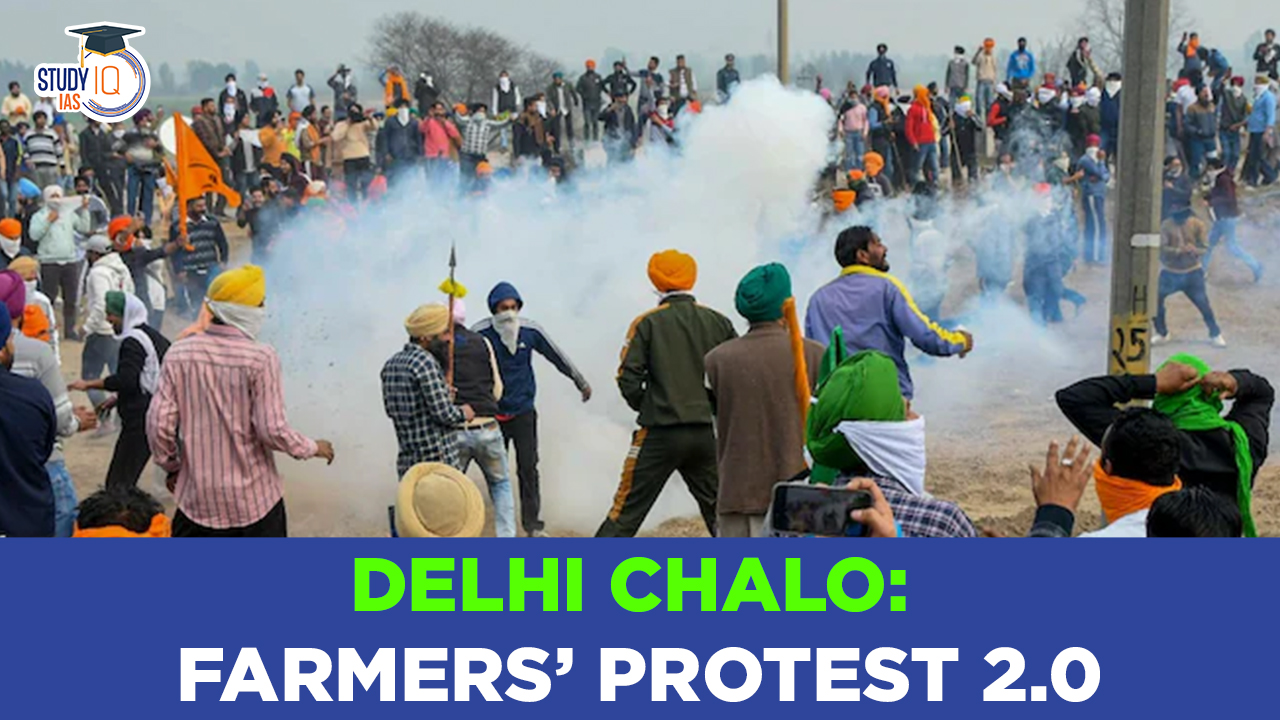Table of Contents
The 2024 Indian farmers’ protest, which commenced on February 13, 2024, marks a significant resurgence of farmer agitation in India, echoing the sentiments and demands of the 2020–2021 protests. The protest, primarily led by the Samyukt Kisan Morcha and the Kisan Mazdoor Morcha, encompasses a multitude of farmer organizations representing the agrarian community’s interests across the nation.
The Farmers Protest 2.0 underscores persistent grievances regarding minimum support prices, agricultural reforms, loan waivers, social security benefits, and crop insurance schemes. It reflects the enduring struggle of farmers to secure fair compensation and sustainable livelihoods amidst evolving economic policies and challenges in the agricultural sector.
Farmers Put ‘Delhi Chalo’ March on Hold
Farmers near Delhi pause their protest march as the government suggests a five-year plan to purchase pulses, maize, and cotton at MSP. Talks in Chandigarh ended with farmers deliberating the proposal for two days. The plan entails cooperative societies contracting with farmers, potentially curbing imports and bolstering local economies. Punjab CM Bhagwant Mann participates in discussions. The ‘Delhi Chalo’ march, demanding various reforms including MSP for 23 crops, continues with thousands of farmers. They seek higher duties on imports amidst low farm earnings exacerbated by export curbs and climate challenges.
Delhi Chalo: Farmers’ Protest 2.0
The “Delhi Chalo: Farmers’ Protest 2.0” commenced on February 13, 2024, with demands including monthly pensions for farmers over 60 and fixed daily wages under MGNREGA. Seeking legal assurance of Minimum Support Price (MSP) for all crops and the implementation of Swaminathan Committee recommendations, protesters confront barricades at borders, facing tear gas and rubber bullets. Notable leaders’ absence complicates negotiations, highlighting persistent agrarian grievances and the urgent need for government engagement in India’s agricultural reform.
We’re now on WhatsApp. Click to Join
Farmers Protest 2.0 Background
The genesis of the protest lies in the persistent grievances of farmers regarding agricultural policies and economic hardships. Despite the Indian government’s repeal of three controversial farm laws passed in 2020, namely the Farmers’ Produce Trade and Commerce (Promotion and Facilitation) Act 2020, the Farmers (Empowerment and Protection) Agreement on Price Assurance and Farm Services Act 2020, and Essential Commodities (Amendment) Act 2020, farmers continue to demand systemic reforms and assurances.
Farmers Protest 2.0 Overview
| Facts | Description |
| Start Date | February 13, 2024 |
| Duration | Ongoing |
| Location | India |
| Main Participants | Samyukt Kisan Morcha, Kisan Mazdoor Morcha, and over 150 farmer organizations |
| Key Demands |
|
| Methods | Demonstrations, marches towards National Capital Region (NCR) New Delhi. |
| Result | Violent clashes at border points, deployment of police forces, internet suspension, and Section 144 imposition. |
| Current Status | Ongoing negotiations between farmers’ leaders and government officials. |
| Government Response | Pressure to address farmers’ concerns and facilitate dialogue. |
| Notable Absences | Leaders from previous protests such as Darshan Pal, Joginder Singh Ugrahan, Rakesh Tikait, Balbir Singh Rajewal, and Gurnam Singh Charuni. |
| Impact | Highlights deep-seated challenges in the agricultural sector, and underscores the need for comprehensive reforms. |
Key Demands of Farmers Protest 2.0
Financial Security
- Farmers above 60 years demand a monthly pension of ₹10,000.
- A fixed daily wage of ₹700 under the Mahatma Gandhi National Rural Employment Guarantee Act (MGNREGA) with a guarantee of 200 days of work annually.
Market Support
- Legal Guarantee of Minimum Support Price (MSP) for All Crops: The central demand of the protest is a legal framework guaranteeing MSP for all agricultural produce.
- Implementation of Swaminathan Committee Recommendations: Farmers seek the implementation of recommendations made by the M.S. Swaminathan Committee to improve income and welfare, including infrastructure development, research and development, and market reforms.
Other Demands
- Withdrawal of cases registered during the last agitation in 2020-21.
- Pensions for farmers, loan waivers, and withdrawal from the World Trade Organization.
- Ensuring at least 50% profit over the overall cost of production.
Farmers Protest 2.0 Protest Dynamics
Tens of thousands of farmers have converged at the borders, intending to march towards the National Capital Region (NCR) of New Delhi. However, the authorities have barricaded the borders and deployed police forces to prevent their entry. Violent clashes have erupted at various border points, particularly at the Shambu border between Haryana and Punjab, where tear gas and rubber bullets were employed to disperse the agitating crowds. Internet services have been suspended in several districts of Haryana, and Section 144 has been imposed, limiting public gatherings.
Government Response For Farmers Protest 2.0
The Indian government faces mounting pressure to address the farmers’ concerns and facilitate dialogue to resolve the impasse. However, negotiations between farmers’ leaders and government officials have yet to yield substantial outcomes. The government’s approach to the protest remains a subject of scrutiny, with calls for constructive engagement and resolution of the longstanding issues raised by the agricultural community.
What are the Reforms Needed?
Policymakers negotiate with farmers over the demands made by the farmers.
- Redefining Minimum Support Price (MSP): Expand the MSP regime beyond the current 23 crops, which constitute only 28% of the value of agriculture and allied produce.
- Equal MSP Implementation: If the government makes MSP based on Cost C2 plus 50% margin legally binding for the current MSP crops, the same formula should apply to all agricultural products, including livestock and horticulture.
- Growth in Non-MSP Sectors: Livestock and horticulture, which make up more than 50% of agricultural produce and grow at a rate of 5 to 8%, should receive the same benefits as MSP crops despite growing without any MSP support.
- Learning from Success Models: Emulate successful integrated value chain models like Amul for milk and vertically integrated poultry sectors to reduce market risks and stabilise incomes.
- Productivity and Market Access: Enhance farmers’ incomes by increasing productivity sustainably and providing access to the best markets, both domestic and international.
- Investment in Agriculture R&D and Irrigation: Commit to long-term investments in research and development as well as irrigation to improve productivity.
- Policy Reforms for Market Access:
- Remove export bans on agricultural products.
- Eliminate stocking limits on private trade.
- Stop selling wheat and rice below the economic cost from FCI, as these are anti-farmer measures.
- Rebalancing Subsidy Policies: Rethink subsidies to ensure a larger proportion supports producers rather than consumers. For example, reorient the food and fertilizer subsidies to benefit farmers directly.
- Creation of a Price Stabilization Fund: Allocate a significant portion of subsidies towards establishing a fund to stabilise prices for farmers.
- Targeted Consumer Subsidies: Redirect only a small fraction of subsidies to the most vulnerable consumers, while the majority should support the producers.
- Rational Policy Making: Move away from populist measures (‘revdis’) and develop rational policies that truly balance the interests of both producers and consumers.
Farmers Protest 2.0 Protest UPSC
The ongoing 2024 Indian farmers’ protest underscores the deep-seated challenges faced by the agricultural sector in India and the urgent need for comprehensive reforms to ensure farmers’ livelihoods and welfare. As the protest continues to unfold, stakeholders, including the government, farmers’ organizations, and civil society, must engage in meaningful dialogue and concerted efforts to address the underlying issues and pave the way for a sustainable and equitable agricultural future.


 Places in News for UPSC 2025 for Prelims...
Places in News for UPSC 2025 for Prelims...
 Growth in Gold Loans and NPAs, Reasons a...
Growth in Gold Loans and NPAs, Reasons a...
 New Phase of Operation Chakra to Combat ...
New Phase of Operation Chakra to Combat ...





















